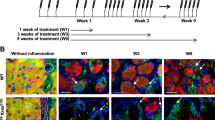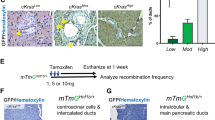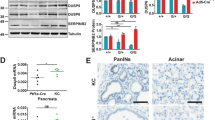Abstract
Epidermal growth factor receptor (EGFR) signaling has a critical role in oncogenic Kras-driven pancreatic carcinogenesis. However, the downstream targets of this signaling network are largely unknown. We developed a novel model system utilizing murine primary pancreatic ductal epithelial cells (PDECs), genetically engineered to allow time-specific expression of oncogenic KrasG12D from the endogenous promoter. We show that primary PDECs are susceptible to KrasG12D-driven transformation and form pancreatic ductal adenocarcinomas in vivo after Cdkn2a inactivation. In addition, we demonstrate that activation of KrasG12D induces an EGFR signaling loop to drive proliferation. Interestingly, pharmacological inhibition of EGFR fails to decrease KrasG12D-activated ERK or PI3K signaling. Instead our data provide novel evidence that EGFR signaling is needed to activate the oncogenic and pro-proliferative transcription factor c-MYC. EGFR and c-MYC have been shown to be essential for pancreatic carcinogenesis. Importantly, our data link both pathways and thereby explain the crucial role of EGFR for KrasG12D-driven carcinogenesis in the pancreas.
This is a preview of subscription content, access via your institution
Access options
Subscribe to this journal
Receive 50 print issues and online access
$259.00 per year
only $5.18 per issue
Buy this article
- Purchase on Springer Link
- Instant access to full article PDF
Prices may be subject to local taxes which are calculated during checkout




Similar content being viewed by others
References
Ardito CM, Gruner BM, Takeuchi KK, Lubeseder-Martellato C, Teichmann N, Mazur PK et al. EGF receptor is required for KRAS-induced pancreatic tumorigenesis. Cancer Cell 2012; 22: 304–317.
Navas C, Hernandez-Porras I, Schuhmacher AJ, Sibilia M, Guerra C, Barbacid M . EGF receptor signaling is essential for k-ras oncogene-driven pancreatic ductal adenocarcinoma. Cancer Cell 2012; 22: 318–330.
Lemmon MA, Schlessinger J, Ferguson KM . The EGFR family: not so prototypical receptor tyrosine kinases. Cold Spring Harb Perspect Biol 2014; 6: a020768.
Eser S, Schnieke A, Schneider G, Saur D . Oncogenic KRAS signalling in pancreatic cancer. Br J Cancer 2014; 111: 817–822.
Puri S, Folias AE, Hebrok M . Plasticity and dedifferentiation within the pancreas: development, homeostasis, and disease. Cell Stem Cell 2015; 16: 18–31.
Reichert M, Rustgi AK . Pancreatic ductal cells in development, regeneration, and neoplasia. J Clin Invest 2011; 121: 4572–4578.
Kopp JL, von Figura G, Mayes E, Liu FF, Dubois CL, Morris JP et al. Identification of Sox9-dependent acinar-to-ductal reprogramming as the principal mechanism for initiation of pancreatic ductal adenocarcinoma. Cancer Cell 2012; 22: 737–750.
Pylayeva-Gupta Y, Lee KE, Hajdu CH, Miller G, Bar-Sagi D . Oncogenic Kras-induced GM-CSF production promotes the development of pancreatic neoplasia. Cancer Cell 2012; 21: 836–847.
Lee KE, Bar-Sagi D . Oncogenic KRas suppresses inflammation-associated senescence of pancreatic ductal cells. Cancer Cell 2010; 18: 448–458.
Morton JP, Mongeau ME, Klimstra DS, Morris JP, Lee YC, Kawaguchi Y et al. Sonic hedgehog acts at multiple stages during pancreatic tumorigenesis. Proc Natl Acad Sci USA 2007; 104: 5103–5108.
Appleman VA, Ahronian LG, Cai J, Klimstra DS, Lewis BC . KRAS(G12D)- and BRAF(V600E)-induced transformation of murine pancreatic epithelial cells requires MEK/ERK-stimulated IGF1R signaling. Mol Cancer Res 2012; 10: 1228–1239.
Zhang W, Nandakumar N, Shi Y, Manzano M, Smith A, Graham G et al. Downstream of mutant KRAS, the transcription regulator YAP is essential for neoplastic progression to pancreatic ductal adenocarcinoma. Sci Signal 2014; 7: ra42.
Boj SF, Hwang CI, Baker LA, Chio II, Engle DD, Corbo V et al. Organoid models of human and mouse ductal pancreatic cancer. Cell 2015; 160: 324–338.
Conradt L, Godl K, Schaab C, Tebbe A, Eser S, Diersch S et al. Disclosure of erlotinib as a multikinase inhibitor in pancreatic ductal adenocarcinoma. Neoplasia 2011; 13: 1026–1034.
Sibilia M, Fleischmann A, Behrens A, Stingl L, Carroll J, Watt FM et al. The EGF receptor provides an essential survival signal for SOS-dependent skin tumor development. Cell 2000; 102: 211–220.
Perera RM, Bardeesy N . Ready, set, go: the EGF receptor at the pancreatic cancer starting line. Cancer Cell 2012; 22: 281–282.
Soucek L, Whitfield J, Martins CP, Finch AJ, Murphy DJ, Sodir NM et al. Modelling Myc inhibition as a cancer therapy. Nature 2008; 455: 679–683.
Soucek L, Whitfield JR, Sodir NM, Masso-Valles D, Serrano E, Karnezis AN et al. Inhibition of Myc family proteins eradicates KRas-driven lung cancer in mice. Genes Dev 2013; 27: 504–513.
Saborowski M, Saborowski A, Morris JP, Bosbach B, Dow LE, Pelletier J et al. A modular and flexible ESC-based mouse model of pancreatic cancer. Genes Dev 2014; 28: 85–97.
Walz S, Lorenzin F, Morton J, Wiese KE, von Eyss B, Herold S et al. Activation and repression by oncogenic MYC shape tumour-specific gene expression profiles. Nature 2014; 511: 483–487.
Hessmann E, Schneider G, Ellenrieder V, Siveke JT . MYC in pancreatic cancer: novel mechanistic insights and their translation into therapeutic strategies. Oncogene 2015; e-pub ahead of print 29 June 2015; doi:10.1038/onc.2015.216.
Bonal C, Thorel F, Ait-Lounis A, Reith W, Trumpp A, Herrera PL . Pancreatic inactivation of c-Myc decreases acinar mass and transdifferentiates acinar cells into adipocytes in mice. Gastroenterology 2009; 136: 309–319 e309.
Nakhai H, Siveke JT, Mendoza-Torres L, Schmid RM . Conditional inactivation of Myc impairs development of the exocrine pancreas. Development 2008; 135: 3191–3196.
Schild C, Wirth M, Reichert M, Schmid RM, Saur D, Schneider G . PI3K signaling maintains c-myc expression to regulate transcription of E2F1 in pancreatic cancer cells. Mol Carcinog 2009; 48: 1149–1158.
Schönhuber N, Seidler B, Schuck K, Veltkamp C, Schachtler C, Zukowska M et al. A next-generation dual-recombinase system for time- and host-specific targeting of pancreatic cancer. Nat Med 2014; 20: 1340–1347.
Hann SR . Role of post-translational modifications in regulating c-Myc proteolysis, transcriptional activity and biological function. Semin Cancer Biol 2006; 16: 288–302.
Vervoorts J, Luscher-Firzlaff J, Luscher B . The ins and outs of MYC regulation by posttranslational mechanisms. J Biol Chem 2006; 281: 34725–34729.
Pinho AV, Rooman I, Reichert M, De Medts N, Bouwens L, Rustgi AK et al. Adult pancreatic acinar cells dedifferentiate to an embryonic progenitor phenotype with concomitant activation of a senescence programme that is present in chronic pancreatitis. Gut 2011; 60: 958–966.
Pinho AV, Rooman I, Real FX . p53-dependent regulation of growth, epithelial-mesenchymal transition and stemness in normal pancreatic epithelial cells. Cell Cycle 2011; 10: 1312–1321.
Solar M, Cardalda C, Houbracken I, Martin M, Maestro MA, De Medts N et al. Pancreatic exocrine duct cells give rise to insulin-producing beta cells during embryogenesis but not after birth. Dev Cell 2009; 17: 849–860.
Jörs S, Jeliazkova P, Ringelhan M, Thalhammer J, Durl S, Ferrer J et al. Lineage fate of ductular reactions in liver injury and carcinogenesis. J Clin Invest 2015; 125: 2445–2457.
Yin X, Giap C, Lazo JS, Prochownik EV . Low molecular weight inhibitors of Myc-Max interaction and function. Oncogene 2003; 22: 6151–6159.
Schreiber FS, Deramaudt TB, Brunner TB, Boretti MI, Gooch KJ, Stoffers DA et al. Successful growth and characterization of mouse pancreatic ductal cells: functional properties of the Ki-RAS(G12V) oncogene. Gastroenterology 2004; 127: 250–260.
von Burstin J, Diersch S, Schneider G, Reichert M, Rustgi AK, Schmid RM . Detection of tumor suppressor genes in cancer development by a novel shRNA-based method. Mol Cancer Res 2015; 13: 863–869.
Sancho R, Gruber R, Gu G, Behrens A . Loss of Fbw7 reprograms adult pancreatic ductal cells into alpha, delta, and beta cells. Cell Stem Cell 2014; 15: 139–153.
Ischenko I, Zhi J, Moll UM, Nemajerova A, Petrenko O . Direct reprogramming by oncogenic Ras and Myc. Proc Natl Acad Sci USA 2013; 110: 3937–3942.
Ischenko I, Petrenko O, Hayman MJ . Analysis of the tumor-initiating and metastatic capacity of PDX1-positive cells from the adult pancreas. Proc Natl Acad Sci USA 2014; 111: 3466–3471.
Reichert M, Takano S, von Burstin J, Kim SB, Lee JS, Ihida-Stansbury K et al. The Prrx1 homeodomain transcription factor plays a central role in pancreatic regeneration and carcinogenesis. Genes Dev 2013; 27: 288–300.
Land H, Parada LF, Weinberg RA . Tumorigenic conversion of primary embryo fibroblasts requires at least two cooperating oncogenes. Nature 1983; 304: 596–602.
Wang C, Lisanti MP, Liao DJ . Reviewing once more the c-myc and Ras collaboration: converging at the cyclin D1-CDK4 complex and challenging basic concepts of cancer biology. Cell Cycle 2011; 10: 57–67.
Skoudy A, Hernandez-Munoz I, Navarro P . Pancreatic ductal adenocarcinoma and transcription factors: role of c-Myc. J Gastrointest Cancer 2011; 42: 76–84.
Mazur PK, Herner A, Mello SS, Wirth M, Hausmann S, Sanchez-Rivera FJ et al. Combined inhibition of BET family proteins and histone deacetylases as a potential epigenetics-based therapy for pancreatic ductal adenocarcinoma. Nat Med 2015; 21: 1163–1171.
Zhou Q, Law AC, Rajagopal J, Anderson WJ, Gray PA, Melton DA . A multipotent progenitor domain guides pancreatic organogenesis. Dev Cell 2007; 13: 103–114.
Sandgren EP, Quaife CJ, Paulovich AG, Palmiter RD, Brinster RL . Pancreatic tumor pathogenesis reflects the causative genetic lesion. Proc Natl Acad Sci USA 1991; 88: 93–97.
Grippo PJ, Sandgren EP . Acinar-to-ductal metaplasia accompanies c-myc-induced exocrine pancreatic cancer progression in transgenic rodents. Int J Cancer 2012; 131: 1243–1248.
Lin WC, Rajbhandari N, Liu C, Sakamoto K, Zhang Q, Triplett AA et al. Dormant cancer cells contribute to residual disease in a model of reversible pancreatic cancer. Cancer Res 2013; 73: 1821–1830.
Sandgren EP, Luetteke NC, Qiu TH, Palmiter RD, Brinster RL, Lee DC . Transforming growth factor alpha dramatically enhances oncogene-induced carcinogenesis in transgenic mouse pancreas and liver. Mol Cell Biol 1993; 13: 320–330.
Ventura A, Kirsch DG, McLaughlin ME, Tuveson DA, Grimm J, Lintault L et al. Restoration of p53 function leads to tumour regression in vivo. Nature 2007; 445: 661–665.
Hingorani SR, Petricoin EF, Maitra A, Rajapakse V, King C, Jacobetz MA et al. Preinvasive and invasive ductal pancreatic cancer and its early detection in the mouse. Cancer Cell 2003; 4: 437–450.
Wirth M, Stojanovic N, Christian J, Paul MC, Stauber RH, Schmid RM et al. MYC and EGR1 synergize to trigger tumor cell death by controlling NOXA and BIM transcription upon treatment with the proteasome inhibitor bortezomib. Nucleic Acids Res 2014; 42: 10433–10447.
Muzumdar MD, Tasic B, Miyamichi K, Li L, Luo L . A global double-fluorescent Cre reporter mouse. Genesis 2007; 45: 593–605.
de Alboran IM, O'Hagan RC, Gartner F, Malynn B, Davidson L, Rickert R et al. Analysis of C-MYC function in normal cells via conditional gene-targeted mutation. Immunity 2001; 14: 45–55.
Madisen L, Zwingman TA, Sunkin SM, Oh SW, Zariwala HA, Gu H et al. A robust and high-throughput Cre reporting and characterization system for the whole mouse brain. Nat Neurosci 2010; 13: 133–140.
Acknowledgements
We thank Drs S. Hingorani, I. Verma, D. Tuveson, H. Zeng, F. Costantini, T. Jacks, R. DePhino, J. Ferrer, I. de Alboran and F. Alt for generating or providing mouse lines/plasmids. This work was supported by the Wilhelm-Sander Foundation (2012.084.1 to GS), Deutsche Forschungsgemeinschaft (DFG) (SCHN 959/1-2, SCHN 959/2-1 to GS, GE2289/1 to FG, SI 1549/2-1 to JTS and SFB824 to GS and DS), Deutsche Krebshilfe (110908 to GS, 111273 (Max-Eder Program) to MR and 109992 to JTS) and NIH (NIH P30 DK050306 Center for Molecular Studies in Digestive and Liver Diseases (Molecular Pathology and Imaging, Molecular Biology/Gene Expression, Cell Culture, and Transgenic and Chimeric Mouse Cores) to MR and AKR and the NIH R01 DK060694 to MR and AKR).
Author contributions
Concept and design of the research: SD, MW, CS, SJ, FG, MR, RMS, DS, AKR and GS; realization of research: SD, MW, CS, SJ, FG and MR; analysis and interpretation of data: all authors; support with essential reagents/analytical tools: JTS, RR, DS, AKR; JTS, FG, DS, MR, AKR and GS obtained funding; SD, MW, MR and GS wrote the paper. All authors discussed the results, commented on the manuscript, revised it critically for important intellectual content and approved the final version of the manuscript.
Author information
Authors and Affiliations
Corresponding author
Ethics declarations
Competing interests
The authors declare no conflict of interest.
Additional information
Supplementary Information accompanies this paper on the Oncogene website
Rights and permissions
About this article
Cite this article
Diersch, S., Wirth, M., Schneeweis, C. et al. KrasG12D induces EGFR-MYC cross signaling in murine primary pancreatic ductal epithelial cells. Oncogene 35, 3880–3886 (2016). https://doi.org/10.1038/onc.2015.437
Received:
Revised:
Accepted:
Published:
Issue Date:
DOI: https://doi.org/10.1038/onc.2015.437
This article is cited by
-
The genetic landscape of pancreatic head ductal adenocarcinoma in China and prognosis stratification
BMC Cancer (2022)
-
Differential impact of the ERBB receptors EGFR and ERBB2 on the initiation of precursor lesions of pancreatic ductal adenocarcinoma
Scientific Reports (2020)
-
Pancreatic ductal adenocarcinoma: biological hallmarks, current status, and future perspectives of combined modality treatment approaches
Radiation Oncology (2019)
-
MTOR inhibitor-based combination therapies for pancreatic cancer
British Journal of Cancer (2018)
-
Critical role of Myc activation in mouse hepatocarcinogenesis induced by the activation of AKT and RAS pathways
Oncogene (2017)



